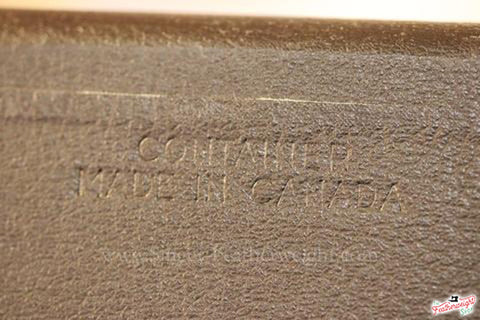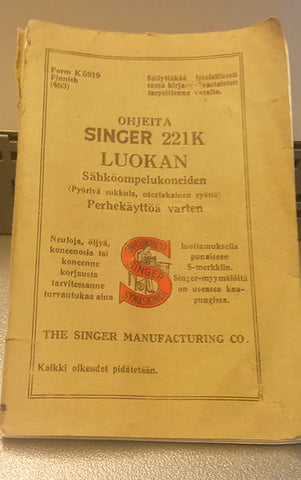Taxes and discounts calculated in checkout.
BROWSE SCHOOLHOUSE
 Featherweights From Foreign Countries
Featherweights From Foreign Countries


I am sure there are some of you who have found peculiar things on your machine or among the accessories. While Featherweights were only produced in three countries (USA, UK & Canada), they were sold worldwide. Singer often added decals, logos and extra accessories with machines sold in different countries, and here I will show many of the peculiarities that we have seen here in the shop.
Canada
The Canadian Featherweight History is quite unique and can be a little bit confusing, but hopefully we will be able to shed a little bit of light on the topic. Canada only produced the Tan 221J Featherweights in their Saint John's Quebec factory, but they made parts like motors and cases for the Black and White Featherweights that were sold there. It is speculated that the black and white Featherweight bases and housings were made in the Kilbowie and New Jersey factories, but the machines were finished in Canada. We do not know why Singer would have done this, but there could have been import charges on finished products, and Singer also wanted to be able to label the machines as "Made in Canada."


In this Canadian advertisement there is a decal underneath the machine badge reading "Made in Canada."
Singer did outsource their case manufacturing, and some of the cases even with US marketed Featherweights were stamped, "Made in Canada."


In the photo above, the motor indicates that it was "Made in Canada". This is a Canadian motor that would have been put on UK made Featherweights sold in Canada.

Even the tan Featherweights that were not made in Canada still had motors that were marked "Made in Canada" (see photo above).

Singer also sold 222K Featherweights in Canada. The machines were, of course, made in the UK, but they were fitted with "Canadian" 110 volt motors when they were sold in Canada.
France:
Singer sold both 221K and 222K Featherweights in France throughout nearly the entire production of Featherweights in the UK. The Featherweights that were sold in France were all made in Kilbowie, Scotland, and they are often quite unique. One of the first things you might notice about the Featherweights marketed in France is that they almost always have 110v motors that were made in Great Britain. Most of Europe was switching from 110v power over to 220v during the 1950s, so that is possibly the reason the Singer used these 110v motors. Those of you who have purchased one of these machines were probably pleasantly surprised when it arrived, and you realized you could run it on our US current. These motors are often identified by an "A.P." on the motor. Because the power/current output was sort of in a limbo stage during the 1940s and 1950s, Singer also often included power converters with the Featherweights sold in France.



Another interesting trait about the "French" 221K Featherweights is their extra decal(s). During 1950-1951 the 221K Featherweights sold in France had a unique French decal on the back arm.

Sometimes you might see a similar decal on the underside of the controller.

The final but obvious difference with these "French Featherweights" is that the manuals are written in French!
Spain and Mexico:
The Featherweights that were marketed to Spain and Mexico are usually in the 1947-1951 era. The ones sold to Spain were made in the UK, and the ones sold to Mexico were made in the US, but were often fitted with Canadian motors. These unique Featherweights can be characterized by a couple things:
The first thing you might notice is an M.R. decal that can be seen underneath the badge and underneath the "Singer Manufacturing Co." decal on the back.

An "M.R." decal, abbreviated for "Marcas Registrar" began appearing on a few machines in 1947. M.R. is the Spanish equivalent to ® or TM in that it was given for exclusive rights to a product, name, slogan, etc. for Latin-American and Spanish countries. It is worth noting that though these machines were intended for the Spanish and Latin American markets, some machines with this decal never left the USA and the UK.
The second interesting oddity is the manual that is often included with these machines.

The Spanish-written manual is actually much more thorough than the "English" reading Featherweight manuals. It includes very extensive parts diagrams on the back pages. If only they made manuals like this for all Featherweights!

What is this silver cylinder in my machine!?!
Those of you who have a Featherweight sold in the UK, Europe and Australia will often find a silvery cylinder somewhere inside your machine. These are called capacitors, and they were used to counteract feedback with the old television sets or radios. A capacitor can be found in either the foot controller, underneath the machine itself, and even in the motor. If you happen to have one, you will want to take them out, as they have been known to cause the machine to run on its own.


The rest of the world:
In other places such as Germany, Australia and the Middle East, we have not found any other significant differences, but if you have a Featherweight marketed in a different country than what we have mentioned here, and you find something quite unique, please contact us.

Here is a photo of a very peculiar 221K that we found. It has a plaque on it with some writing in Swedish. Thanks to our Featherweight Friend Sophia S. from Sweden, the plaque has been translated to read the following:
Singer
Electrical sewing machine
Type 221k2 Input 60 watt.
Current: see the motor’s infoplate.
Below are some photos of Featherweight manuals written in different languages:

221 manual written in Swedish
The translation of the ”Featherweight” on the manual says ”lättvikt,” which feels like they have translated it from the boxing term ”Featherweight” to the Swedish boxing term equivalent ”lättvikt.”
221 manual written in French

221 manual written in Finnish
Photo Credit: Henrik T.

221K Manual written in Italian
Photo Credit: Lorenzo Donato

221K Manual written in Norwegian

222 manual written in French

222 manual written in Dutch
Feel free to email us photos if you have Featherweight manuals in other languages, and if you ever find a Featherweight with something that looks odd or foreign, refer back to this post. I will continue to update it as more Featherweight mysteries unfold.





 Featherweights From Foreign Countries
Featherweights From Foreign Countries
